A dismal August brings a soggy end to a dismal summer.
Monday, August 31, 2015
It has been difficult at times to put a positive spin on all the
challenges gardeners in this part of the world have had to face in
this so called summer. When like us you also open your garden
for the NGS it adds to the pressure to keep it looking good for all
our visitors. By nature I am an enthusiastic and optimistic
person but reviewing my recent monthly website News it is
hard to believe it!! So hopefully you will find this News a little
more positive and uplifting.
Late summer borders in the Paddocck Garden

The month started on a massive high with our trip to
Middle England and the 3 Manors (for more details go to our News
item dated 12 August). During the month there were several
meteorological highlights including the "Blue Moon" and an
incredible sunset on one of the days when a meteor shower was
expected. Continuing the Blue Moon" theme we had blue balloons at
the end of the month when a wedding party used the gardens for
their photos.
A not so "blue moon" on a cloudy night
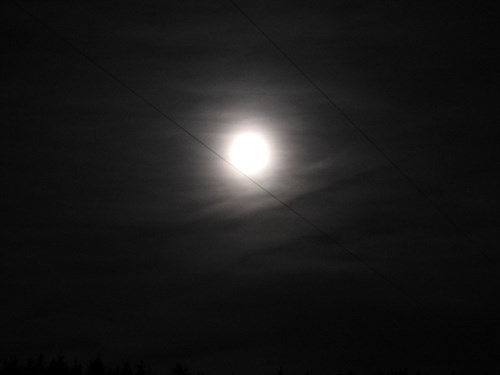
At least the ballons were blue -ish!!
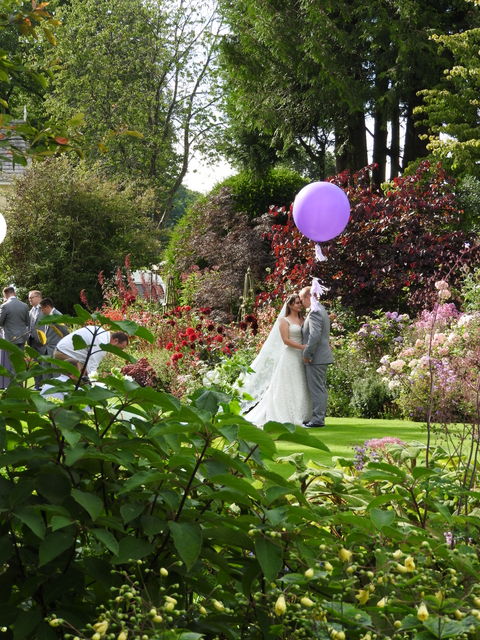
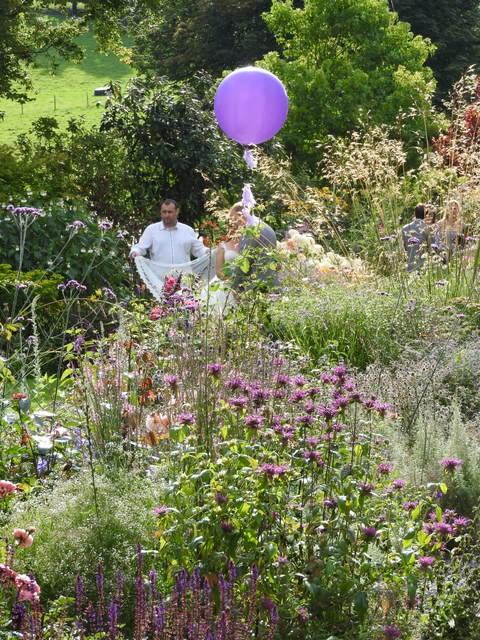
And the best sunset I have seen for a long
time

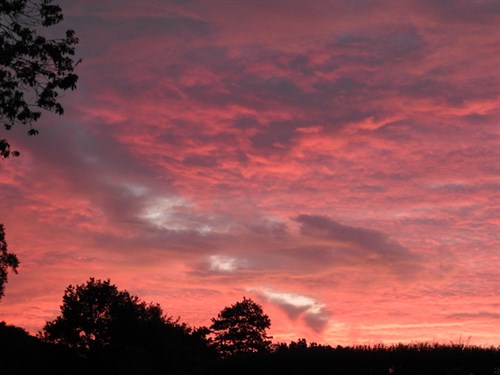
The cooler conditions and lack of sunshine extended the
flowering period of many plants so that August was still a very
colourful month even though the blooms of rain sensitive plants
like roses and dahlias were quickly damaged in some of the heavy
downpours. Lots of dead heading to do on these and on the daylilies
many of which at the end of the month were still flowering long
after they usually finish.
One of the latest of the seed grown hemerocallis to come
into flower and one of the best

So cheer up, read on and just to make you feel better the
forecasters are saying that Sepetember is going to be better!!!
Weather
However cheerful I try to be the weather was just lousy
throughout the month with the exception of a few plleasnt days. No
long period of setlled weather as we had in the two most recent
Augusts. Cold by day and night, breezy, with torrential rain in the
last week, which brought up the rivers and streams to the highest
levels seen this year.
The stream garden at our friend's Robert and Barry, that
I helped to design and plant up. For the first time after some very
heavy rain it was running freely.
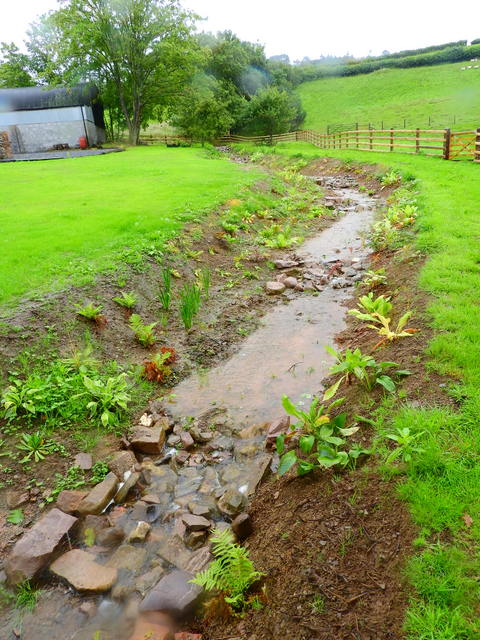
Only 2 days in the whole month above 21C, max 24C on
the day of the wedding 22 August
8 nights below 10c, min 5C 18 August
Barometer levels below 30" for most of the month
Garden Update
Lawns revelled in the cool moist weather looking lush green all
month after I fed them. I lost count of the number of times I was
asked to give give a "Masterclass" on lawn maintenance throughout
the seasons for many of our visitors. All shade loving plants
have thrived and in the main borders, without bright light, colours
became more intense. Roses coped reasonably , well none finer than
the French shrub roses which have such clean black spot free leaves
and relatively rain resistant flowers, Our visitors favourite rose
especially for its fine, old fashioned perfume was La Rose du
Molinard from breeder Delbard. Very vigorous too at 6 feet
tall.
A really mixed bag of vegetables. Those like courgettes, French
and runner beans, sweetcorn, sweet potato, tomatoes
even in the tunnels, struggled badly or were at least 2 week behind
the normal cropping dates. Carrot fly damage was less in evidence
but the crop was still affected so that I am not expecting any to
be in a good enough condition to store for winter. Celery and
celeriac affected by virus and leaf miner.
The veg. garden after the potato
harvest
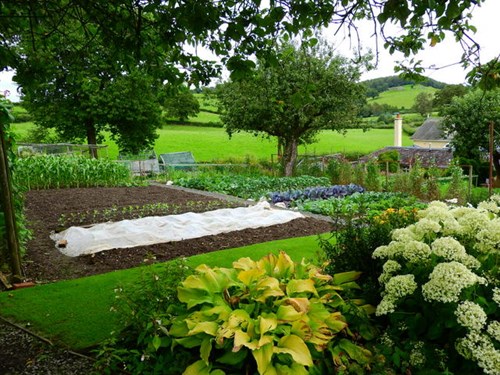
A few carrots managed to avoid the carrot fly and one of
the best and a new one to me was Purple Haze Amazing bicolour which
has a great taste.

Considering a late planting and early harvest I
was pleased with the overall quaility and size of the crop. As ever
the best all round was desiree, and the salad types which store
well and taste new for many months. Charlotte and old favourite but
eclipsed in size by Venezia, a newer variety.

A sight I thought I would never see this year, a row of
Hurst peas. Three reasonable rows to harvest. Nothing beats the
taste of a pea straight from the vine.
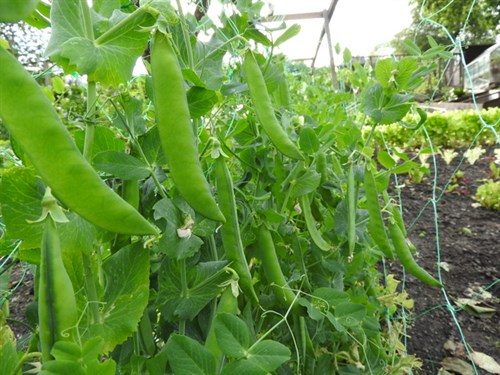
I continue to sow salad leaves as there is still time to
prioduce a harvest before the worst ot the weather arrives,
and after our taste experience at Le Manoir au Quat Saisons,
I have sown a wider range of radish which was widely used in the
restaurant.
This year only small onions and shallots which were planted out
late, but leeks (5 rows of them) are looking good and should
fill any gaps lin supply from the onions.
Sweet peas are still flowering well - enough from 12
wigwams to provide daily bunches for the house and to give away
(always a most acceptable gift, especially when paired up with
ethereal gypsophylla - weren't they just made for each other?)
Sowing them 3 seeds to 9cm pot in January and planting out the
entire pot, one to each cane, in late May has been a great success
this year.

Asters in wide variety looking very promising with plenty of
buds already and no sign of mildew on the nova belgii types.
Staking is essential to show off these autumn beauties at their
best as they flop badly when in full flower. The earlier form aster
frikartii "Monch" has been in flower since late July.
Tender salvias many from Central America do not like the
cold and lack of sunshine so are struggling but there is still time
if September is kind as they thrive on shorter daylight hours. One
genus from Central America that has done particularly well is the
brugmansias, overwintered in huge pots big enought to to just about
carry and stood outside for the summer. Copious watering and
feeding is the key to successful flowering and if they can get it,
some warmth too! Such rays of sunshine in the gloom and a
wonderful scent at nightfall rivalling the regale lilies they are
paired with.
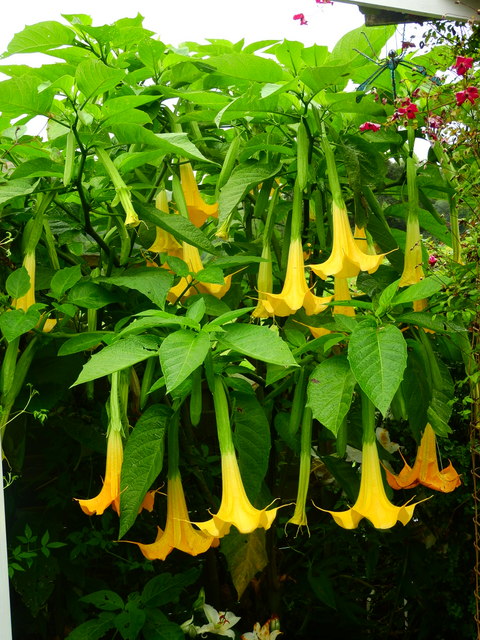
What's looking good?
I can't believe how well the borders are looking nor for how
long plants are staying in good condition. There is almost too much
choice making the final decision difficult but pictures are the
best way to do justice to some of the best.
The Picket Fence border bathed by the soft pink
light of that magical metor shower sunset
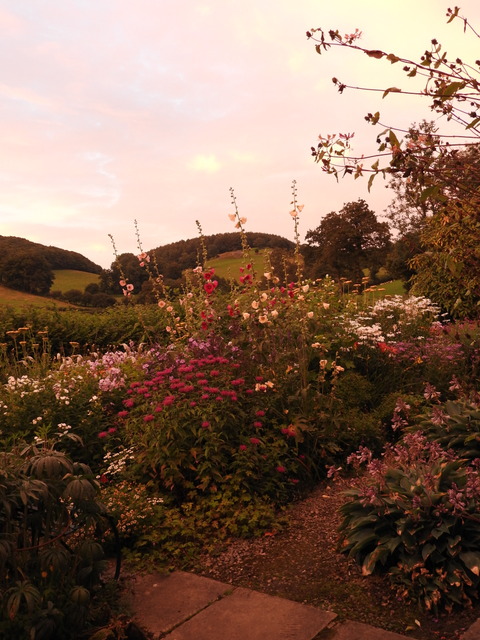
Flower heads on eryngium planum
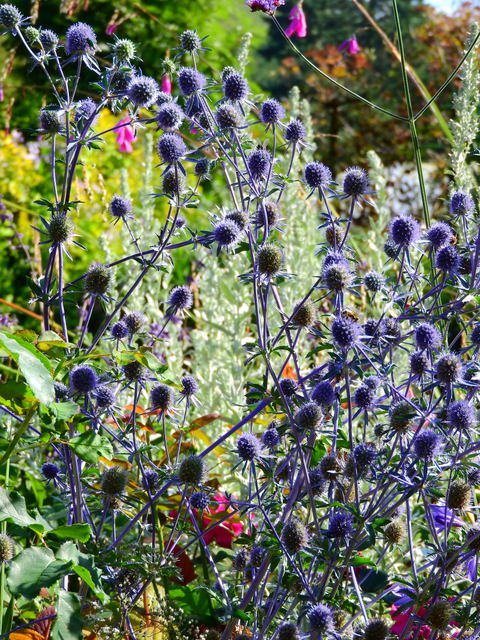
And serious competition from dahlia "Karma Choc"
(the dark one) and "Wittemans Best"

And another pic. of the red border whcih really does
look good this year
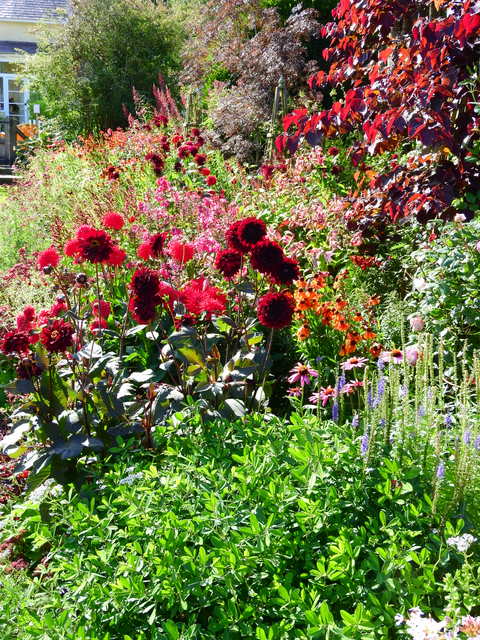
Late clematis can always be relied upon for a good show
and the scented form c. triternata rubromarginata is a
treasure
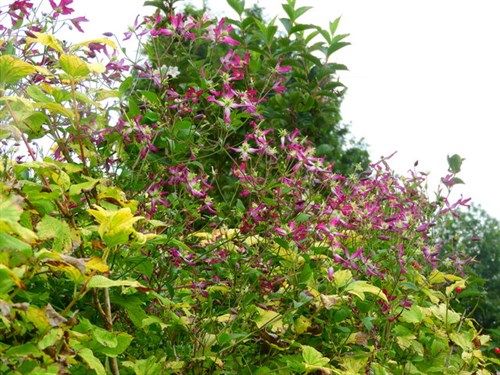
After all the hot colours elsewhere its is nice to
turn to the restful calm of this part of the Paddock Garden shade
border
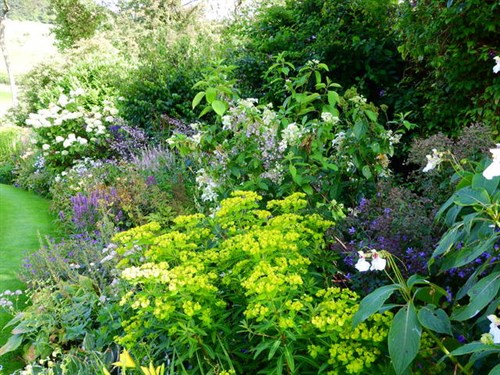
Lilium speciosum "Black Beauty" a long established and
long flowering form to 7 feet

My favourite corner of the House Garden border and
lovely seat to enjoy it!

The Greenhouse Border with some good pokers
(kniphofias) and a mixed colour pallette
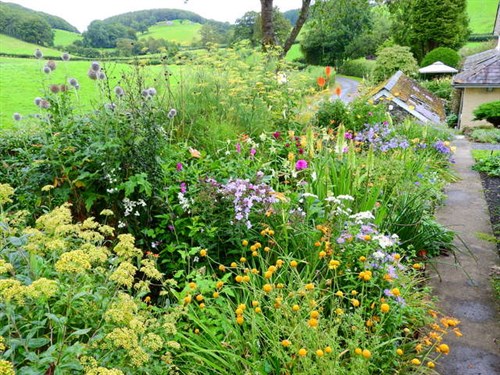
One of the best pokers is "Green jade"
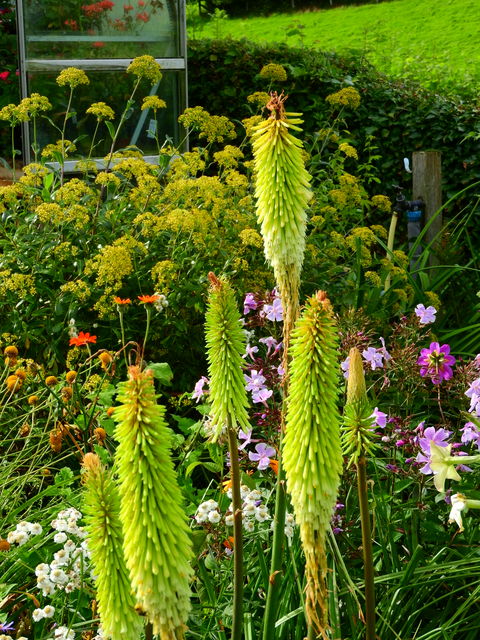
There is however one top contender that deserves a
detailed appreciation. Many gardeners have favourite plants within
a family or genus and start collecting them. Over a period of time
these collections can grow and the urge to add more becomes even
greater as new plants become evailable. Current national favourites
include heucheras, dahlias, meadow plants especially umbellifers,
plants that attract wildlife and of course roses and lilies never
go out of fashion.
In my case my passion is for almost anything!! The
buttercup family, hostas, hellebores, hardy geraniums, and lilies
are long time favourites but over the last 10 years or so another
has joined the club. Ladies and gentlemen I give you hydrangeas!!
Cue big drum roll.
From slow beginnings I was staggered recently when doing a count
of them that we now have over 80 in the gardens. Why do I like them
so much? The variety, ease of cultivation, compatibility with our
location and ease of intergration into our planting schemes. The
only challenge we face is with late spring frost damaging the
emerging flowerbuds on some forms.
The hydrangea bank near the conservatory is packed with
them in wide variety some of which like this macropetylla, I cannot
name. Nice plant with black stems
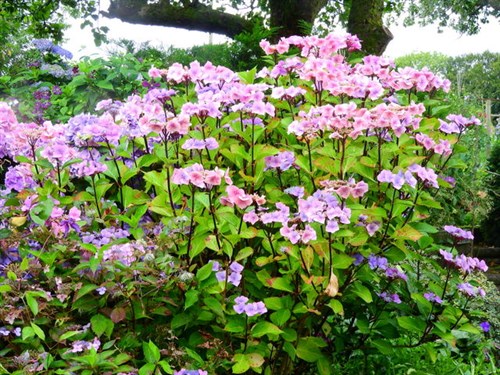
Most common forms are readily available, but even unusual or
rare hydrangeas are relatively easy to purchase thanks to
specialist nurseries such as Pan global Plants or via Internet
search engines, As most gardeners will know they are also easy to
propagate from soft ot hardwood cuttings taken at appropriate times
of the year. Thay have a long season of interest from June until
October with changing flower colours, strong structure, and many of
them have great autumn leaf colour too until the first frosts. One
of the best things here with a soil PH of 6 - 6.5 is that all
hydrangeas that have the capacity in those soil conditions to be
so, are blue, and for me that is much nicer than the washed out
pinks you often see in gardens with alkaline soil.
The main sections available are Macrophyllas (the large mop
headed forms), the more dainty Serratas, well suited to smaller
gardens . Both sections also include delightful lacecap forms and
come in a range of colours. Paniculatas have less colour than the
others, starting white or lime green and graduallly fading
cream or in some cases pink or red. A section of larger
growing forms includes the Aspera group some of which can reach up
to 20 feet tall and as wide, and climbing hydrangeas like
pteolaris and seemanii that can clothe an entire building or tree
in time. A less common section is the Involucratas which have a
different flower bud than all the others, and also species forms of
hydrangeas like Heterophyllas with less showy or colourful flowers
than the others.
One the longest established is macrophylla
"Generale Viscomtesse de Vibraye" from Portmeirion in North
Wales where there are the bluest hydrangeas I have ever
seen.
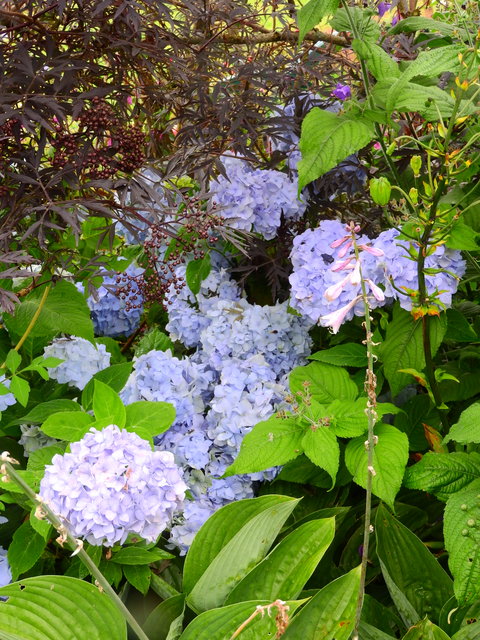
A fine macrophylla lacecap is "Tokyou Delight" The
fertle florets (the circle of petals in the middle) are blue for us
in acid soil: they will be pink in alkaline
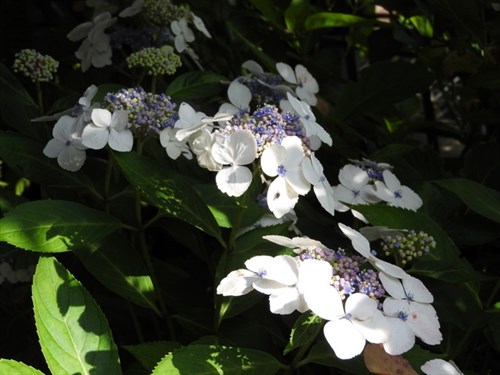
An unclassified form is h. "Preziosa" which assumes
different flower colour depending on soil and location. Even the
summer leaves can turn almost black in full sun in a hot summer.
Two plants in different situations
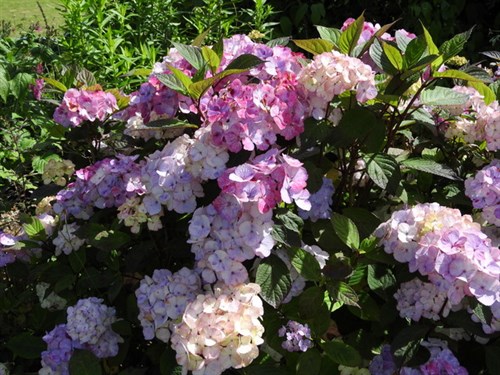

A rightly popular cultivar is h. arborescens "Annabelle"
Long season of flowering and the ability to flower on new wood so
unaffected by late frosts
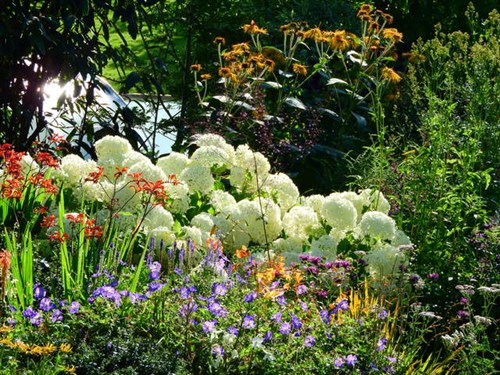
A range of cultivars and a lovely red lililum "Night
Flyer" in part shade

The paniculatas are like Arborescens in that they can
flower on new wood so if you cut them back by a half in the spring
you will get much bigger flowers. Thie one in this pic is
"Limelight"
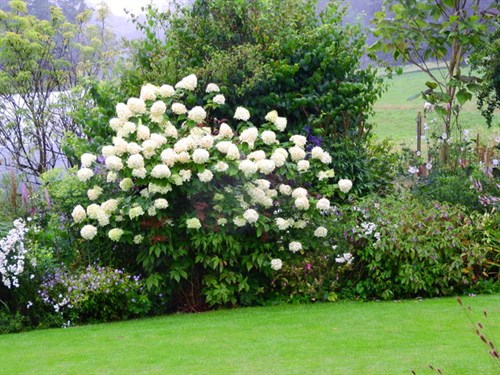
H. paniculata "Kyushu" a lacecap form

Tha amazing form of Paniculata "Vanile Fraise" which
turns from white to deep pink over a long period

One of the bigger forms is h. apera "Macrophylla"
with dinner plate sized blooms. Many fine cultivars in this group
to choose from

The unusual flowerbuds on a rarer form belong to
h.involucrata x kawakami. UNlike all other hydrageas the flowers
emerge from a tightly folded bud
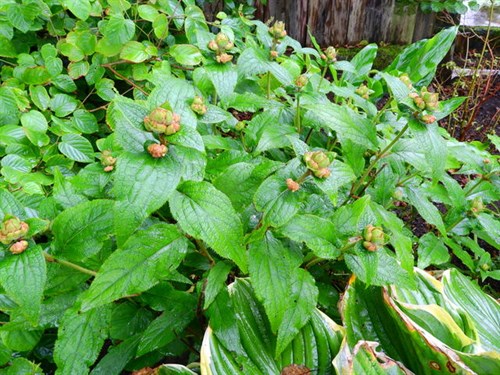
Wildlife and countryside
Best news is the fairly regular sightings of hedgehogs in
the garden. But sadly given how rare they are now, finding a dead
one, run over outside the Lodge recently. was not a pleasant
experience.
Spot the hedgehog in the undergrowth!

Very, very few butterflies (only the occasional Painted
Lady and Peacock sighted in the last few weeks and no dragonflies,
Even cabbage White buttrfies are in short supply (quite pleased
about that really with a garden full of brassicas!!) Wasps are now
much in evidence, quite unlike last year when we scarcely saw
any.
A honey bee searches for pollen on a flower of
geranium "Rozanne". There were thousands of bees
on the many flowers of a large plant. Some years ago there was
another almost identical geranium which was called "Jolly Bee" I
never knew why it had this name until I saw this! Some years
ago however, the owners of the Rozanne name took the other owners
of Jolly Bee took to court to establish the correct name.
"Rozanne" won and the Jolly Bee name cannot
now be used, Pity!
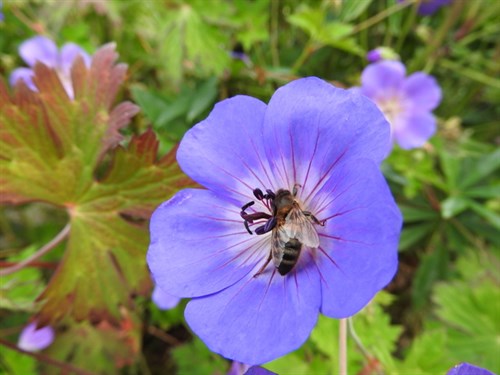
Kingfishers are noisily active their high pitched whistling
calls being heard most days, but even with diligent observation no
chance to photograph any so far, Their presence has made the pond
fish keep to deeper water under cover of the mass of waterlily
leaves. Owls continue to be more vocal as always at this time
of year. Swallows are flying much lower in their pursuiit of flies,
driven down by the veary heavy damp atmosphere.
One morning we saw what looked for all the world like diamond
necklaces strewn all over the heathers on a stone wall near the
conservatory. It was an amazing sight after one especially cold
night
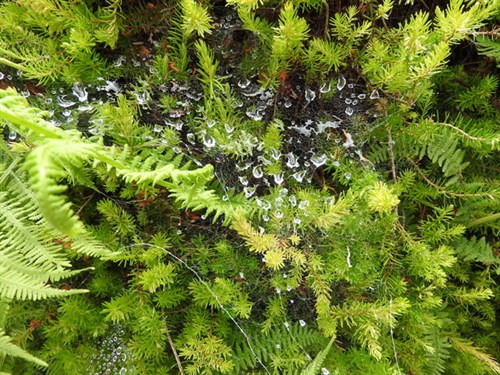
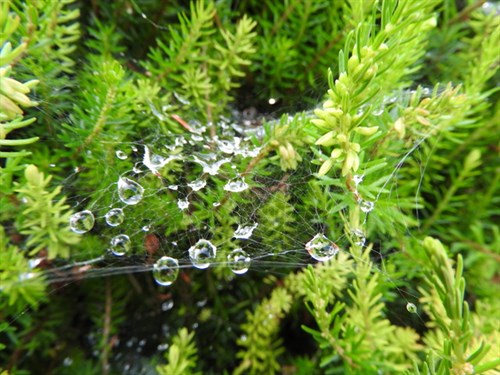
Generally very quiet in the countryside and the birds have
stopped singing for the time being. Hedgcutting (or trashing as it
is called locally) will commence in September as dictated by law to
prevent disturbance of any late nesting birds. Soon it will be time
for the rams to be placed with the ewes when a major yearly
local farming cycle begins again
Having looked good for so long the road verges were cut back
last weeek which is the right time to do it (insteaad of May)
giving us all the chance to enjoy the full bounty of wild flowers
and now that evrything will have self seeded it will be interesting
to see next year how good the flowering period is next year..
But you can always rely on Himalayan balsam to put on a
show in August especially in moist soil even in deep
shade
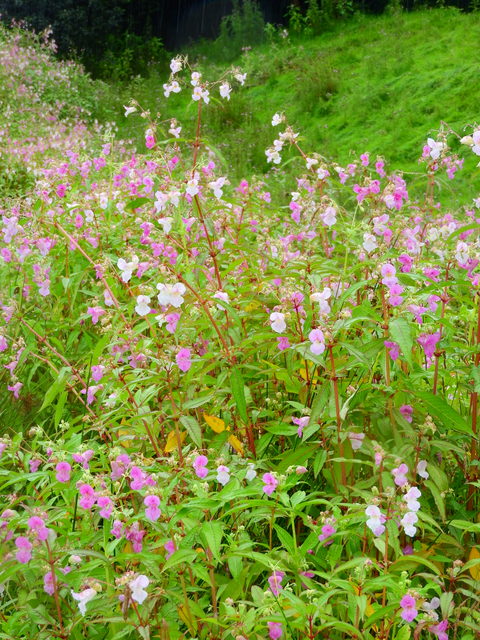
Lovely flowers however despised they may
be

Something I was pleased to see in Buckingahmshire was
this fine stand of bulrushes

Visitors
August with 80 visitors, was the busiest of the 3 months
that we opened for the National Gardens Scheme this year. Overall
we had 187 visitors mostly in small groups and just one coach
party. The tour company from Holland who have been regular visitors
over the years were not able to visit this year Nevertheless with
admissiom monies, teas and plant sales, not to mention several very
generous donations, we were able to raise in the region of £1,300
for the NGS which in a very poor summer was quite an achievement.
Amazingly we only had rain on just one day of the visits! Thanks to
everyone who came this year to support us, for the many generous
compliments and all the cards and e-nmails that followed many of
your visits. It means a great deal to us especially in such a
difficukt year. It is good to know how much our efforts are
appreciated.
Our last group visit was of old friends from our local
Llangadog Gardening Club
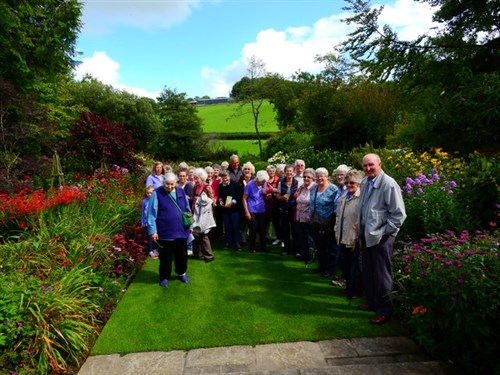
And on our last day we were delighted to welcome
our newest friends (from right to left -Jack, Kat, Michelle
and Ben and their respective babies) all on their first visit to
Wales. What a great way to bring to a close our 2015 opening for
the NGS
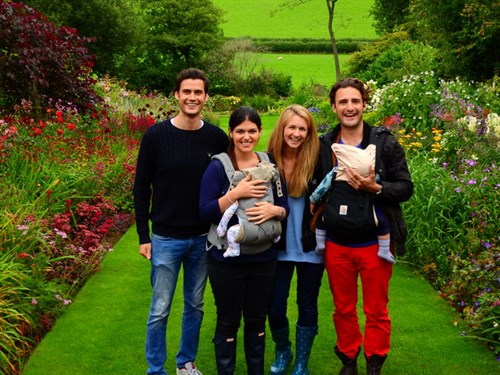
Aside from garden visitors, there were two other revenue streams
- one on a cold day in February when a group of ladies from Brecon
spent 5 hours in my large polytunnel learning the techniques of
plant propagation which was very well received. The other just last
week was the 4th time that we have hosted a wedding party in the
gardens to have photos taken. It is great to be able to use the
gardens in this way and with our local Community Hall and Visitor
Centre now catering for weddings hopefully more of them will come
our way for their photos.
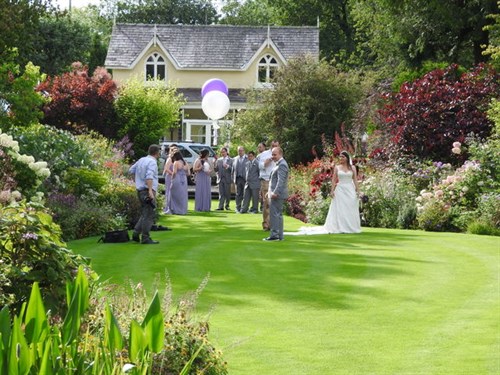
The gardens are now closed for the year but in 2016 we are
opening again for the NGS from June to August - and do you
know what? - we already have 2 bookings and several expressions of
interest!! Our attention now turns to getting out and about more
and to enjoying the garden in what we hope will be a golden autumn.
Ever the optimist.
And two pics to remind us all that aurumn isn't far away.
Amelanchier lamarckii is always the first tree in the
gardens to show autumn colour
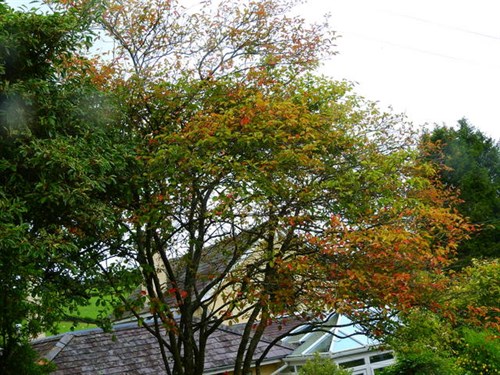
A lovely stand of cyclamen hederifolium also comveys an
autumn feeling to me
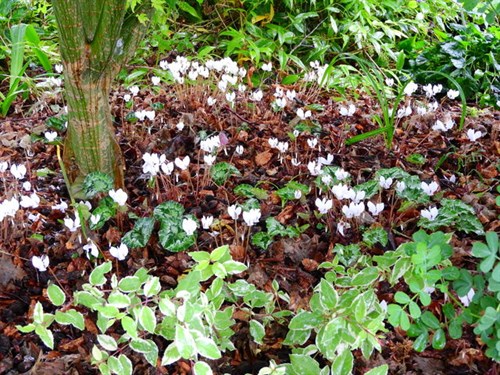
Happy gardening!